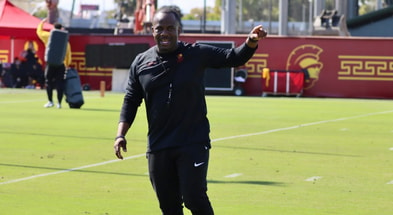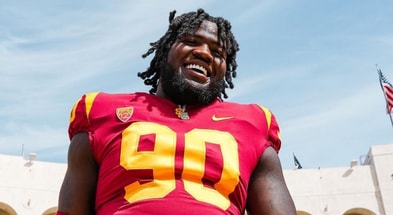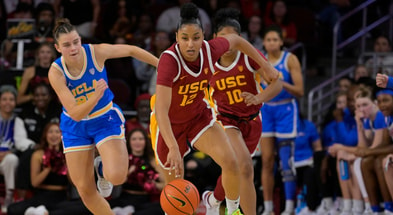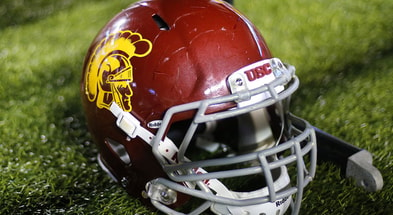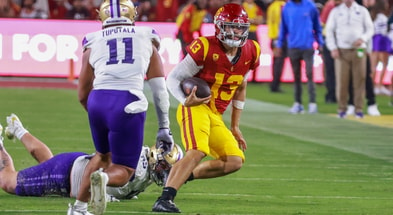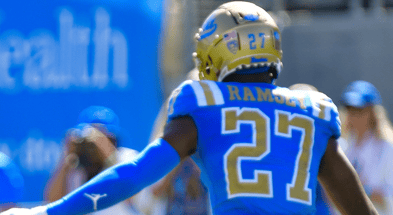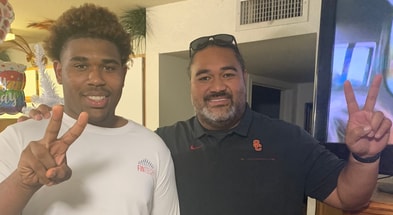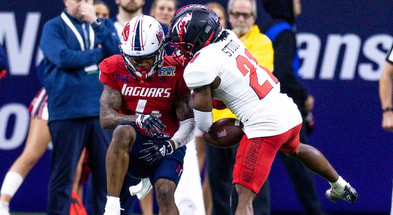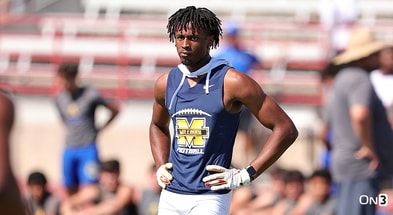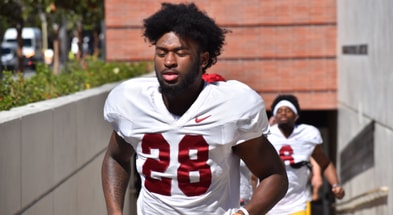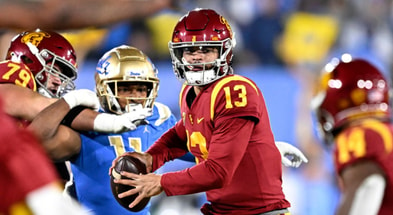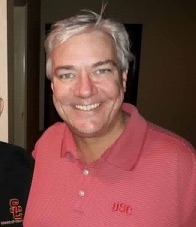Musings with Arledge: Kingsbury, Swann, CA talent pool
Kliff Kingsbury has pulled off a rare feat: get fired from his college job for bad performance, jump straight to the NFL as a head coach anyway, and stab a major college football power in the heart on the way out of town. All in a couple of weeks. That’s impressive.
But where, exactly, does it leave USC?
Lynn Swann conceded in his public statement about Clay Helton in December that serious problems needed to be addressed in the football program:
“We acknowledge and understand our deficiencies in areas that include culture, discipline, schemes, personnel and staff. We agree that changes need to be made, and they will. We will improve and get better, in all areas. Coach Helton has a plan in place to get USC back to the top.”
As evidence that USC could successfully revamp the program while retaining the head coach, Swann pointed to Notre Dame’s rebuild under Brian Kelly:
“We see top programs across the country have down years and the fans want to change coaches. In fact, it happened a few years ago with yesterday’s opponent, but that administration remained committed to their head coach, who made some key changes, worked hard to fix things and got his team to improve markedly. That will happen here at USC.”
So, Mr. Swann, about that “plan … to get USC back to the top.” Unlike Notre Dame, which fired everybody, including the offensive coordinator, defensive coordinator, special teams coordinator, and strength and conditioning coach, USC has retained the defensive coordinator, retained the special teams coordinator, retained the strength and conditioning coach … and does not have an offensive coordinator. As far as the position coaches go, USC’s offensive line coach, wide receivers coach, tight ends coach, and linebackers coach were all on last year’s staff. To date, USC has managed to shuffle some lower-level position coaches. I like the new D line coach. But are we really to believe that the key to USC’s resurrection is replacing Kenechi Udeze with the D line coach from Boise State?
This is why the loss of Kliff Kingsbury is such a big deal. It is why USC possibly took the almost unheard-of step of denying an assistant coach the right to interview for a head-coaching vacancy. Not because Kingsbury was irreplaceable. I think there’s an argument to be made that USC is better off without him. Not in terms of 2019 wins and losses, mind you. Kingsbury was brought in because Clay Helton’s original plan for USC football had failed in spectacular fashion. Helton promised a program based on physical football and a tough running game. Having not recruited or developed an offensive line in three years, he did a 360 and moved to the Air Raid, largely because he has to win games next year, and throwing the ball all over the yard is his only chance to do that, since he hasn’t done what he promised to do when he was hired.
In other words, USC was going to move farther from its roots because Clay Helton needs to win football games right now – regardless of the long-term consequences – and the Air Raid gave him his best chance to do that in 2019. He wasn’t hired to make USC into a Mike Leach-style football program. He didn’t set out to turn USC into a Mike Leach-style football program. He did it because he has lots of receivers, no foundation along the offensive line, and he’s trying to save his job.
I’m not convinced it’s in USC’s interests to move to the Air Raid in order to prolong Clay Helton’s USC career. So losing Kingsbury isn’t the end of the world.
But it is a massive defeat for Lynn Swann and Clay Helton. Swann and Helton publicly sold a plan to re-build USC football, but the only significant change they made – the only change that generated any excitement at all – was hiring Kliff Kingsbury. They put all their eggs in the Kingsbury basket. And now that’s gone. Swann and Helton now have nothing to sell to their fan base or recruits.
Some might argue that this is what happens to an organization that does not have sound leadership in place.
————————-
One more point. I don’t know if Lynn Swann really did temporarily deny Kingsbury the right to interview for NFL head coaching jobs. I hope not, because not only did it not work – he’s still gone – but it could have consequences later.
Trying to deny an assistant coach the opportunity to become a head coach is a very big deal. I don’t think I’ve ever heard of a college program denying one of its assistant coaches the opportunity to interview for a head coaching position. And I’m afraid assistant coaches around the country may take notice.
Just about every coordinator in the country would like to be a head coach. A coach like Kingsbury, who has been a head coach already, is clearly interested in an OC position only insofar as it helps him take over his own program again someday. Coordinators expect that their positions will be a stepping stone to a head job. The people that hire them know this is their goal and know that the expectation is that they will try and land a head coaching job. Thus, denying Kingsbury – or any coordinator – the chance to interview for a head coaching position is not only to get in the way of their primary career goal, but is also runs contrary to the accepted understanding that a coordinator will be loyal to the program only until a desirable head coaching position opens up. It has always been that way.
————————————————-
Is USC at a disadvantage because of a dwindling talent pool in California? Rick Neuheisel has commented about how west coast players look smaller. The south now dominates the list of top recruits and the NFL draft. Various posters on this board have argued that west coast schools have a difficult time competing for talent and that the problem will only get worse.
The question I have is whether the demographics have changed remarkably since 2000. Why 2000? Because USC hired Pete Carroll in December of 2000, and I think we can safely conclude that it was possible for USC to compete with other elite football programs at that time.
So how have things changed demographically in the last 18 years? Can USC still compete?
I’m going to focus here solely on the racial and ethnic demographics as opposed to cultural differences, largely because it is impossible to quantify these cultural differences. Football is more important in the south. I live in Texas after having lived in southern California for most of my life; I understand that football is a bigger deal here. But it’s impossible to quantify how much more important football is in Texas v. California now versus in 2000. Football has been more important in Texas (and other parts of the south) for a very long time. The book Friday Night Lights came out in 1990 and described the 1988 football season, showing the insanity in Texas football 30 years ago. Football is bigger in the south, but that didn’t happen in the last few years.
Do changing racial and ethnic demographics make it difficult or impossible for USC to compete in football now as opposed to 2000 when Pete Carroll was hired? Certainly, it’s a fair question to ask. 68% of NFL players are African-American. The US population as a whole is only 13% African-American. If you want to compete at the highest level today, you must be able to recruit black players.
Or, put another way, the whiter a state, the less likely it is that the state will have large numbers of elite football players. Kansas and Mississippi have about the same population. But Kansas has 163,000 African-Americans, and Mississippi has over a million African-Americans. And Mississippi has produced three times the number of active NFL players.
Much has been made of California’s changing demographics; the state has become more Asian and Latino over the years. Those are not ethnic groups that have traditionally supplied large numbers of elite football players. Putting aside the question whether we will see more elite football recruits from these communities in the future – that strikes me as pure speculation – let’s focus instead on how changing demographics impact USC’s ability to recruit in communities that have traditionally provided elite football recruits.
The first thing we need to do is get rid of racial and ethnic percentages as the key metric. In other words, when the argument begins, “California is now __% Asian,” you’re already talking about the wrong thing. What matters is whether California can provide enough blue-chip talent to stock USC’s roster, not what the current racial and ethnic mix is compared to prior years.
Let’s assume, and it seems like a safe assumption in retrospect, that on the day Pete Carroll was hired, California had enough elite high school football players to allow USC to compete with other college football powers. Now let’s assume that the very next day, 10 million immigrants from Atlantis settled in California, and that none of those immigrants had ever played football or would ever take up the sport. This change would have dramatically changed the percentage composition of the different ethnic and racial groups in California – the percentages for all the racial and ethnic groups then living in California would have gone down significantly. But it would not have changed the fact that California would still have had ample elite talent to stock an elite college football team. The existence of a large number of new, non-football-playing Atlantians would not have changed the fact that Shaun Cody, Darrell Rideaux, and Reggie Bush were nearby. What matters is total numbers.
What are those numbers? In 2000, 2.26 million African-Americans lived in California, and African-Americans made up 6.7% of the state’s population. The census department estimates that California now has an African-American population of 2.35 million – a slight increase in total numbers, though African-Americans now make up only 5.9% of the state’s population.
What can we take from this? There has not been a mass exodus of African-Americans from California. And if the bulk of elite recruits will continue to come from the African-American community, it is not immediately obvious why USC is at a significant disadvantage now versus 2000.
It is possible, of course, that USC is at a relative disadvantage if the black communities in other states have increased in size relative to California’s black community. And they may have, although the difference doesn’t seem dramatic. In 2000, 6.2% of the nation’s African-Americans lived in California. In 2018, about 5.3% of the nation’s African-Americans live in California. This is obviously a decrease, but it does not seem like the sort of dramatic shift that would take USC from being placed in a recruiting hotbed to being place in a location that makes it impossible to compete on the gridiron. This modest change just isn’t dramatic enough to justify that conclusion.
My take? The demographic argument for USC’s decline is overblown. Ohio has a much smaller African-American community than California does – 1.3 million people versus 2.35 million. Yet Urban Meyer has little trouble fielding a competitive football team. USC is losing, and people look for reasons. But there are always reasons why the current regime can’t win. Pundits were calling USC “Yesterday U” before Pete Carroll arrived also.
It’s still possible to win at USC. But that requires changes on the inside more than it does changes in California’s demographics.
——————————————
Kevin and my podcast this week is all about speed. We’ll be talking to two track stars: Tyson Gay, the fastest American in history and the second-fastest man ever behind Usain Bolt, and Monzavous Rae Edwards, an elite sprinter (former member of the US national team who was still running sub-10 in the 100 last year at the age of 35) and burgeoning speed guru. We’re going to ask them whether there is truth to the old adage that you can’t teach speed. We’ll discuss what football players and coaches need to know and do to run faster. We’ll talk about the mental side of elite sports competition; how do you have your mind right when the next 10 seconds will determine your career, and Usain Bolt is in the next lane? And we’ll talk about PED’s, their prevalence, and what should be done about them. I hope you join us.
——————————
USC Game of the Past
September 19, 1970
Nebraska at USC
This is not a game that is on the radar for most USC fans. The previous week, USC destroyed Alabama at their place, and that game has gone in the pantheon on great college football games. And for good reason, as Sam Bam’s destruction of the Tide played an important role in integrating southern football.
But the following week USC game home to play #9 Nebraska. The Trojans had destroyed Nebraska the previous year in Lincoln, but this was a new day. Three times Nebraska took a lead, and three times the Trojans came back to tie it. And when Jimmy Jones’ hail mary fell short at the end of the game, the Trojans and Huskers ended the game tied at 21.
The game has meant little for Trojan fans. USC went on to a disappointing season, and only the Alabama game is remembered. But for Huskers fans, the game was a big deal. The tie with USC was the only blemish on Nebraska’s record that year, and Nebraska’s now-legendary Bob Devaney (with second-year offensive coordinator, Tom Osborne) won his first national title.
Note what kind of schedule USC was playing in those days. USC’s non-conference schedule in 1970 was at Alabama, home against Nebraska (which finished the season #1), at Iowa, and home against Notre Dame (which finished #2 after beating top-ranked Texas in the Cotton Bowl). Anyone, anytime, anywhere indeed.
